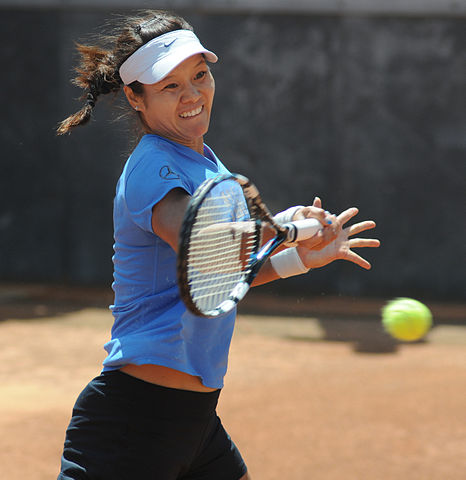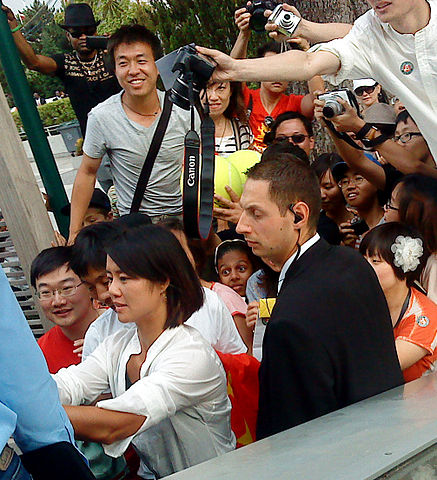
In 2022, I’m counting down the 128 best players of the last century. With luck, we’ll get to #1 in December. Enjoy!
* * *
Li Na [CHN]Born: 26 February 1982
Career: 1999-2014
Plays: Right-handed (two-handed backhand)
Peak WTA rank: 2 (17 February 2014)
Peak Elo rating: 2,160
Major singles titles: 2
Total WTA singles titles: 9
* * *
We tend to think of Li Na as a late bloomer. She didn’t crack the top ten until she was nearly 28 years old. Her first major had to wait another year beyond that, and she only added her second when she was a month shy of her 32nd birthday. So it’s true, the best player yet to come out of China didn’t reach her potential until very late in the traditional woman’s career trajectory.
On the other hand, Li was a highly regarded star as a teen in China, winning national competitions in addition to a whopping 14 ITF singles titles before her 20th birthday. It was hardly a guarantee that the Wuhan native would eventually achieve a single-digit ranking, but it was clear that China’s strongest prospect was poised to make a dent on a wider stage.
Then she quit.
* * *
It’s tough to consider Li Na’s story from the vantage point of February 2022 without also thinking about Peng Shuai. After accusing Communist Party bigwig Zhang Gaoli of sexual assault last November, mentions of Peng’s name were censored online, and she immediately disappeared from public view. Her only public appearances since then–including with International Olympic Committee boss Thomas Bach–have reeked of government stage-management. She crossed a line that, in China, means that she may spend the rest of her life under the threat of further government retribution.
While Peng is a few years younger than Li, her doubles peak coincided with Li’s final season in 2014. In a 12-month span, Li won the Australian Open, and Peng grabbed doubles titles at Wimbledon, the French Open, and the Year-End Championships. The success of Li, Peng, and 2008 Olympic doubles medalists Zheng Jie and Yan Zi marked China as a rising force in the sport. After the Beijing games, these four women earned the unusual–for China–right to “fly solo,” managing their own careers and paying their own expenses, in exchange for keeping most of their earnings instead of kicking the majority back to the national federation. Before that, the federation controlled every detail of its players’ careers, just as other Chinese national organizations dictate things in nearly every other sport.
Last month, Chinese dissident architect Ai Weiwei offered some context for Peng Shuai’s position in China: “She is a sports person, which is like being a soldier in the army. Any person in sport is considered as property of the party.”
Li Na never fell afoul of the Party to the extent that Peng has, and one hopes she hasn’t experienced anything that would trigger an accusation as earth-shaking as Peng’s. Her iconoclasm was often embraced, even held up as an example of an emerging type of Chinese celebrity. But not for nothing did Li call her self a “bad-tempered, stubborn girl,” and lesser bursts of individualism angered both fans and functionaries. “Flying solo” or not, some degree of military obedience was expected of her.
In her late teens, Li began to recognize these limits to her freedom. At least in the eyes of the authorities, she was in fact a soldier. That wasn’t what she signed up for when a local coach spotted the aptitude of a seven-year-old girl and convinced her family that her future might lie in an unfamiliar game.
* * *
Li Na retired for the first time in 2002. With a world ranking that snuck inside the top 200 shortly after her 20th birthday, she gave up competition and went to Huazhong University to study journalism. She continued to play tennis casually, and over the next two years, her old teammates and coaches showed up more and more frequently, until she gave in to the pressure and returned to competitive tennis.
Her game barely suffered from the break. She went 34-3 with five titles on the ITF tour upon her return in 2004, including a tournament win in Mongolia on dirt (not clay–dirt) courts. All that changed was her mindset. In her telling, she began to play more for herself, and the shift worked well enough that she climbed into the top 20 within two years, setting new records for Chinese players every step of the way.
Only after a semi-final showing at the 2008 Beijing Olympics did the rules of the game change for Li. Given the rights and responsibilities of flying solo, she hired a personal coach–Thomas Hogstedt–for the first time, and she increasingly relied on medical care and rehab in Europe. Only then, at age 26, did she gain the individualized support that was taken for granted by the women ahead of her in the rankings.
Five years later, Li was a French Open champion and top-five player. Former WTA CEO Stacey Allaster called her “the most important player of this decade” in 2013, comparing her impact to that of Venus and Serena Williams. She flew solo, but the slipstream behind her was incomprehensibly vast.
* * *
It’s hard to overstate Li Na’s impact on women’s tennis. If it weren’t for her success, Wuhan would have never have hosted a major tournament–or maybe any tour-level event. Nor would there be so much of a Chinese presence on the WTA schedule that the tour’s response to the government’s treatment of Peng Shuai would make headlines around the world. At the same time, the woman swinging the racket never wanted much to do with the symbolic global celebrity.

In her autobiography, Li reacted to those who proclaimed her French Open title as a triumph for China: “I can’t carry a nation … I can’t represent anyone else, nor do I want to. I only want to represent myself.”
Her on-court exploits are difficult to separate from her off-court story. There is probably no other all-time great who sat out a couple of years in her early 20s and only neared her potential at age 29. It’s worth looking closer at her record, if only to better understand what might have been.
Li’s two years at university were hardly the only span that delayed her career development. Nagging knee pain finally forced her to go under the knife in mid-2007 for the first of what would be three surgeries. Again she roared out of the gates upon her return, returning to the tour in January 2008 with a tournament win in Gold Coast, beating a teenage Victoria Azarenka in the final. But it would be 2010 before she finally felt confident in the repaired joint.
* * *
While there’s no precise moment when Li graduated from an also-ran to an elite player, a good approximation is her first grass-court title, a win in Birmingham in 2010 with a straight-set defeat of Maria Sharapova in the final. It moved her into the top ten (though she’d quickly bounce back out), and it presaged a quarter-final run at Wimbledon that ended with a credible showing against Serena Williams.
From very early in her career, there was little doubt that Li could compete with the best. Her first encounter with a top-ten player was in 2004, when she qualified in Beijing and drew world #5 Svetlana Kuznetsova. She reached match point and pushed the Russian to a third-set tiebreak. Between 2007 and 2010, she won 17 of her 35 meetings with top tenners, six of the losses going to deciding sets. By the time she won Birmingham, she had scored victories over Serena, Venus, Kim Clijsters, Caroline Wozniacki, Jelena Jankovic, and Elena Dementieva.
At the end of that span, she was 28 years old, a contemporary of multi-major winners Serena, Clijsters, and Justine Henin. Yet she had really only played one full season, in 2009.
The lack of tour experience meant that she was still learning how to bounce back from tough losses. After Wimbledon in 2010, three of her next four events ended in defeats at the hands of Klara Koukalova, Yanina Wickmayer, and Kateryna Bondarenko. She reached the Australian Open final to start 2011… then failed to win a match until April. Her title at Roland Garros that year brought an even harsher hangover. She won only seven matches in eight events over the rest of the season.
* * *
Li finally showed what she was capable of for a full season in 2012. She won just a single title–in Cincinnati–but limited herself only a pair of first-round losses. She fell victim to a particularly strong field and some bad draw luck in 2012, losing to Serena, Azarenka (three times), Sharapova (three times), Clijsters, Wozniacki, and Agnieszka Radwanska. But she rarely stopped fighting–10 of her 17 losses that year required a third set.
The Match Charting Project offers a glimpse into the strengths of the player she had become. Her serve was never a weapon, but her returns were as deep and deadly as any in the game. In the 2012 Montreal final against big-serving Petra Kvitova, nearly nine in ten of her returns landed beyond the service line, and half reached the backmost quarter of the court. When Petra served to her forehand, two-thirds of the returns came back to the deepest quarter, compared to a tour average of only 40%.
Kvitova wasn’t the only opponent whose serves triggered an immediate counterattack. Volunteers have charted 28 of her matches, including most of her finals. According to the Return Depth Index (RDI) statistic, Li ranks second only to Wozniacki among her contemporaries, evidence that she neutralized the serve as well as anyone.
Li’s newfound consistency stuck with her for the remaining season and a half of her career. She also proved able to develop new skills into her 30s, working with coach Carlos Rodriguez to bring a more aggressive game to Wimbledon. At The Championships in 2013, she lost in the quarters to Radwanska, yet came to the net 71 times. Match Charting Project data indicates that she over her career, she typically did so a mere 13 times per match, only about half of those by choice.
In 2014, she won the Australian Open, and a month later ascended to a new career-best ranking of #2. Four months after that, another knee injury would knock her off the tour for good.
* * *
Li retired at age 32, nothing out of the ordinary for a tennis star. Yet it’s hard not to wonder what might have been.
Her career trajectory would make more sense if it belonged to someone five years younger. Instead of a 22-year-old clobbering ITF competition and coming out of nowhere to nearly upset Svetlana Kuznetsova, imagine a 17-year-old doing so. 23-year-olds are more likely than 28-year-olds to establish an initial beachhead in the top ten. The five-year adjustment would make Li 27 years old in 2014, winning a second major and reaching #2 in the world rankings.
That fictitious, younger player would have had surgery and come back in 2015, ready to contend for more slams. She might still be competing on tour in 2022. In all likelihood, she’d be a few dozen places higher on this list. Not only did Li Na assemble an all-time great resume, she packed it all into what was essentially a partial career.
Half a career, yet one that changed Chinese tennis, altered the geography of the global game, and introduced hundreds of millions of new fans to the sport. Quite a feat for a “bad-tempered, stubborn girl from Wuhan” who played only for herself.